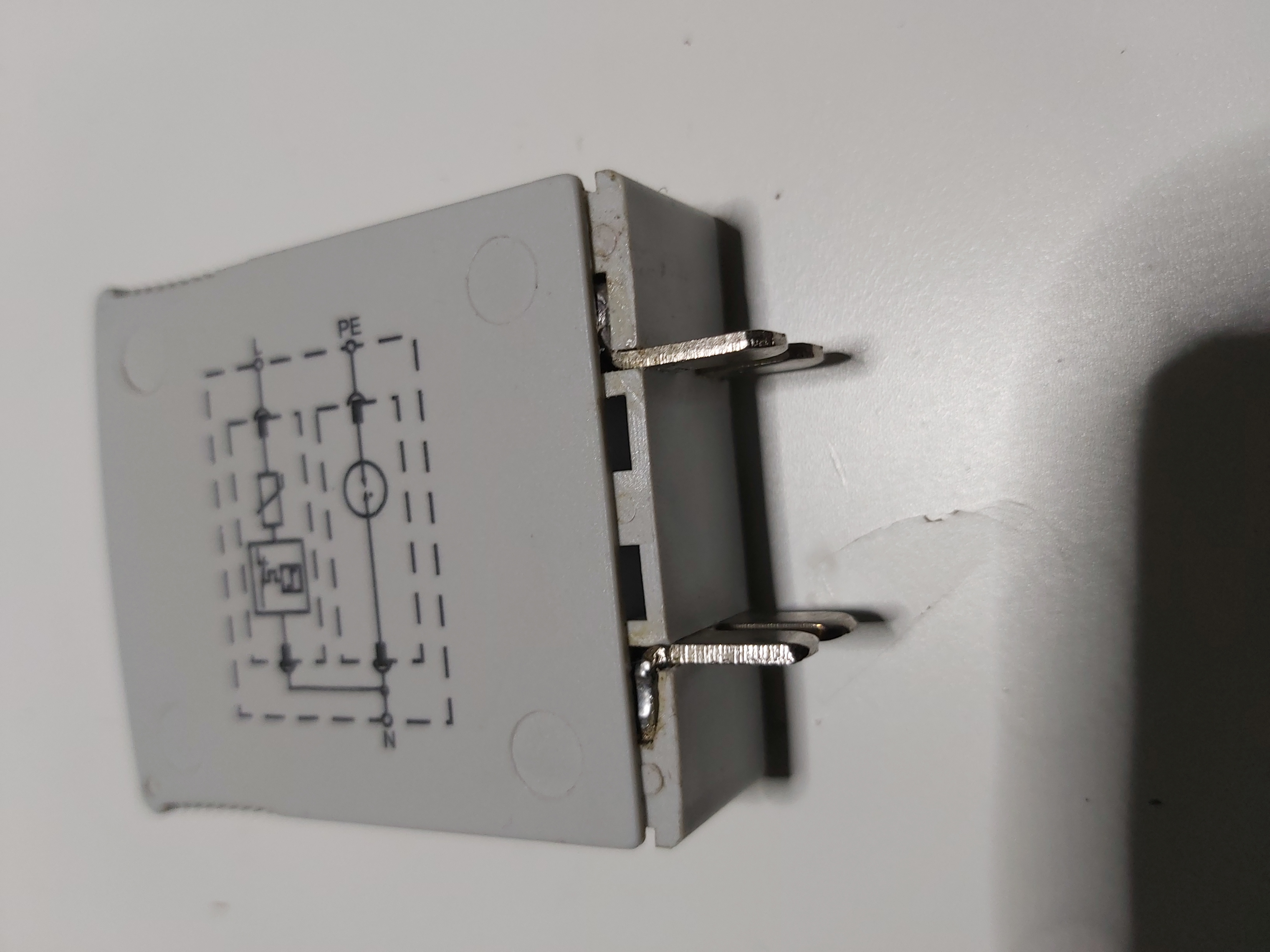I got a mains power (230V AC) surge protector for teardown and analysis. This one is designed to be installed to DIN rail on the small electrical distribution panel or inside electrical equipment.
This one was in original package but already the indicator showed that it was broken.
This protector protects against voltages above 320V AC (Uc) and is designed for circuits that a protected with 32A fuse (or fuse with a smller current rating). In addition there is another protection that rated Up %lt; 1.5 kV.
I removed the protector from holder and started to pry it open. The case shows the block diagram of the protector and how it should be connected to mains power. There seems to be a VDR with an over temperature protector between live and neutral. In addition there is a gas discharge protector from neutral to ground.
Here is the big gas discharge tube that is wired between neutral and protective earth. It seems to have an over temperature protector that has already tripped. The over temperature seems to be made of a spring contact that was soldered to the VDR output wire with some kind of solder (I suspect special low temperature melting solder).
Also the soldering quality on the bottom looks a a bit suspicious.
Here is some testing of the gas discharge tube with my withstand voltage tester. The first meaasurement shows the highest voltage the gas discharge tube can withstand before it triggers and the second picture shows the voltage when the tube has triggered (0.2 mA teat current flows through it).
On the other side there is a huge voltage dependent resistor (VDR) that is protected with overheating protector. The over heating protector seems to be similar spring contact and (low temperature) solder construction.
Here is the test of the voltage over VDR when it starts to conduct (at 0.2 mA test current, goes up slightly somewhat higher with higher test current).







13 Comments
Tomi Engdahl says:
The Importance of 220V Surge Protectors: Safeguarding Your Electronics
https://www.youtube.com/watch?v=aobUHh68P48
In today’s digital age, our lives are heavily reliant on electronic devices. However, they are vulnerable to sudden power surges that can cause irreversible damage. Power surges not only harm your devices but also pose a risk to your data. In this video, we explore the key reasons why investing in a 220V surge protector is a smart choice.
0:00:00 Intro
Importance of Using 220V Surge Protector
Introduction to 220V Surge Protector
How to Use 220V Surge Protector for Electronics?
Considerations When Choosing a 220V Surge Protector
Proper Usage and Maintenance
Tomi Engdahl says:
https://en.wikipedia.org/wiki/Surge_protector
Tomi Engdahl says:
Surge protection without grounded plugs
https://maker.pro/forums/threads/surge-protection-without-grounded-plugs.101869/
Tomi Engdahl says:
What are the Pros and Cons of Whole House Surge Protectors?
https://blog.se.com/sustainability/2022/04/08/what-are-the-pros-and-cons-of-whole-house-surge-protectors/
When weighing the pros and cons of whole house surge protectors versus traditional surge protectors, many people focus on the big, scary lightning strikes. These do happen, and should be protected against, but they’re not the full story.
Tomi Engdahl says:
https://electrocontact.com.ua/content/images/6/408x264l80br0/razryadnik-dlya-zashchity-ot-perenapryazheniytip-3-mnt-1-d-2882200phoenix-contact-94069318797112.webp?fbclid=IwAR279eS3jeGA9Tg62Q15S7IxKoevbj9ljuKyGGUnML6VyTehX4uKOc2GB1I
Tomi Engdahl says:
Incredibly good Meanwell surge protection unit (with schematic)
https://www.youtube.com/watch?v=d1Y1rzVMFq8
With Meanwell being one of the biggest players in the professional power supply industry, I had high expectations of this surge protection unit designed for use with LED drivers in outdoor signage, but also very suitable for many applications where you want to protect expensive electronic circuitry against rogue voltage transients caused by lightning strikes or electrical supply incidents.
The quality of this unit was an absolute treat. Robustly made with no PCB tracks or solder joints to fail. Instead the unit is composed of a housing for three separate thermally protected MOV modules, and the stout wires have been bent and soldered directly to the heavy duty incoming wires.
The unit has been soldered in situ and then filled with coarse white quartz-like sand and then a layer of resin added to reduce the risk of water ingress.
Fault indication is in the form of two traditional gallium phosphide green LEDs that will indicate when a thermal fuse has tripped. The thermal fuses are triggered when the MOVs (Metal Oxide Varistors) reach the end of their useful life and start passing enough current to get hot.
These modules are so rugged and affordable that they would be a good addition to protect HVAC, computer and industrial control systems. In some instances it could be useful as a whole-home protective device.
Tomi Engdahl says:
https://hackaday.com/2023/09/10/industrial-surge-protector-teardown/
Tomi Engdahl says:
Defective surge protector being dumped on eBay
https://www.youtube.com/watch?v=UALm8oomJRg
These surge protectors were being sold as “returns” from a major online retailer at a suspicious price of £10 for four. I felt the urge to buy a set to check out.
It turns out they were perfect for sale on eBay since they have at least one major manufacturing defect that means they can’t indicate when they have ceased to provide protection, and may possibly continue to pass current even when they are supposed to have triggered their thermal safety device.
eBay is full of this stuff because they have no easy way to report a listing for a dangerous product. However, they DO have ways to report items that will undermine their profit.
It’s a shame the UK electrical industry is price gouging SPDs (Surge Protective/Protection Devices), as it encourages people to use rogue imports like these – which may well work, but will not always be made with proper quality control.
Tomi Engdahl says:
UK protector teardown
https://youtu.be/wD7cXGr-ZYs?si=u8ctuk2piB5YGtOe
Tomi Engdahl says:
https://forum.allaboutcircuits.com/threads/how-to-test-a-varistor.189272/
Tomi Engdahl says:
https://youtu.be/79p3ysUnx_Y?si=P7g3DX6rTvi8YrUE
https://audiosciencereview.com/forum/index.php?threads/zerosurge-2r15w-surge-protector-review.41298/
Tomi Engdahl says:
https://forums.stevehoffman.tv/threads/zero-surge-brick-wall-surgexdifferences-and-alternatives.974368/
https://zerosurge.com/2023/01/zero-surge-response-to-audio-science-review-of-a-2r15w/
Tomi Engdahl says:
Surge suppressors: Are SurgeX units the best available? | Audio Science Review (ASR) Forum https://search.app/12QACiRA23z7HZFE9